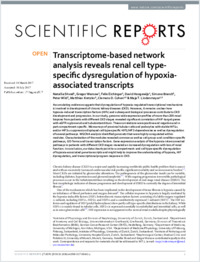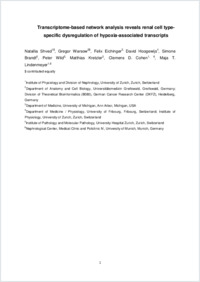Transcriptome-based network analysis reveals renal cell type-specific dysregulation of hypoxia-associated transcripts
- Shved, Natallia Institute of Physiology and Division of Nephrology, University of Zurich, Switzerland
- Warsow, Gregor Department of Anatomy and Cell Biology, Universitätsmedizin Greifswald, Germany - Division of Theoretical Bioinformatics German Cancer Research Center (DKFZ), Heidelberg, Germany
- Eichinger, Felix Department of Medicine, University of Michigan, Ann Arbor, USA
- Hoogewijs, David Department of Medicine/Physiology, University of Fribourg, Switzerland - Institute of Physiology and Division of Nephrology, University of Zurich, Switzerland
- Brandt, Simone Institute of Pathology Molecular Pathology, University Hospital Zurich, Switzerland
- Wild, Peter Institute of Pathology Molecular Pathology, University Hospital Zurich, Switzerland
- Kretzler, Matthias Department of Medicine, University of Michigan, Ann Arbor, USA
- Cohen, Clemens D. Institute of Physiology and Division of Nephrology, University of Zurich, Switzerland - Nephrological Center, Medical Clinic and Policlinic IV, University of Munich, Germany
- Lindenmeyer, Maja T. Institute of Physiology and Division of Nephrology, University of Zurich, Switzerland - Nephrological Center, Medical Clinic and Policlinic IV, University of Munich, Germany
-
17.08.2017
Published in:
- Scientific Reports. - 2017, vol. 7, no. 1, p. 8576
English
Accumulating evidence suggests that dysregulation of hypoxia-regulated transcriptional mechanisms is involved in development of chronic kidney diseases (CKD). However, it remains unclear how hypoxia-induced transcription factors (HIFs) and subsequent biological processes contribute to CKD development and progression. In our study, genome-wide expression profiles of more than 200 renal biopsies from patients with different CKD stages revealed significant correlation of HIF-target genes with eGFR in glomeruli and tubulointerstitium. These correlations were positive and negative and in part compartment-specific. Microarrays of proximal tubular cells and podocytes with stable HIF1α and/or HIF2α suppression displayed cell type-specific HIF1/HIF2-dependencies as well as dysregulation of several pathways. WGCNA analysis identified gene sets that were highly coregulated within modules. Characterization of the modules revealed common as well as cell group- and condition-specific pathways, GO-Terms and transcription factors. Gene expression analysis of the hypoxia-interconnected pathways in patients with different CKD stages revealed an increased dysregulation with loss of renal function. In conclusion, our data clearly point to a compartment- and cell type-specific dysregulation of hypoxia-associated gene transcripts and might help to improve the understanding of hypoxia, HIF dysregulation, and transcriptional program response in CKD.
- Faculty
- Faculté des sciences et de médecine
- Department
- Département de Médecine
- Language
-
- English
- Classification
- Biological sciences
- License
- License undefined
- Identifiers
-
- RERO DOC 305743
- DOI 10.1038/s41598-017-08492-y
- Persistent URL
- https://folia.unifr.ch/unifr/documents/306023
Other files
Statistics
Document views: 64
File downloads:
- hoo_tbn.pdf: 143
- hoo_tbn_sm1.pdf: 105

